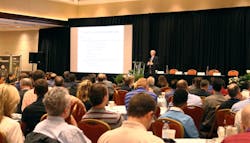In 2012, PMMI Media Group (Automation World’s parent company) launched the annual Automation Conference & Expo. Attendance at the event has grown more than 130 percent since the inaugural conference in 2012. And though the conference has always attracted automation professionals from industrial companies of all sizes, the past few years have shown a definite uptick in the number of IT-oriented professionals attending the conference, as well as corporate executives—which speaks to the increasing pervasiveness of automation technology across industry.
At every Automation Conference and Expo, I come away with many new insights. Following are four key issues that stood out for me this year:
Connecting the shop floor to the top floor has provable value. In his presentation explaining how Dow Corning connected its SAP enterprise resource planning systems to its Siemens PCS 7 controllers in a closed loop scheduling and production system, Tim Morrison, Dow Corning’s global business process manager for production, noted that the automated process associated with this closed loop system reduced error rates from the 10 percent experienced with the previous manual entry process to less than 1 percent. In addition, transactions are enacted in the system as soon as a current phase is complete, rather than having to wait until the start of the next shift. In essence, Dow Corning (now Dow Chemical) has proven that this kind of shop floor to top floor integration is making them operate better and faster.
Remote access to control systems is becoming a corporate demand. Keith Dicharry principle expert and process control, automation and electrical director in BASF’s North America Technical Expertise Organization, noted that corporate management is increasingly asking for “data from everything possible and they want the data to go everywhere. They want everything to connect to everything else, everywhere and be able to access it from anywhere they are on the globe.” He added that BASF is also pushing for remote control. “They used to just want to be able to see everything everywhere, now they want to control everything from anywhere,” Dicharry said. In one of my reports from Hannover Messe this year, I noted how more suppliers are referencing their ability to not just view device data remotely, but control the device itself. Dicharry’s presentation at The Automation Conference & Expo highlights how this move by suppliers is likely in reaction to growing marketplace demands for such abilities.
Cybersecurity approaches still vary widely. Despite years of cybersecurity experts insisting that air gaps separating control systems from the Internet do not really exist, we heard from Chevron’s Cybersecurity Process Control Network (PCN) Vulnerability Assessor, Byron K. Wallace, that air gaps remain a critical component of Chevron’s approach to cybersecurity. Though Wallace agrees that, today, there is no such thing as a “truly isolated system,” he pointed out that maintaining the mindset and policies of officially prohibiting outside connections makes Chevron’s PCN safer than it would otherwise be. All USBs, computers and other devices brought in to connect to the PCN have to go through Chevron’s test lab first to verify there is no presence of malware or other potential threats before being allowed to connect to the PCN. “Our test lab is like a sandbox for our network,” said Wallace. “We can test it and push it out from there.”
Collaborative robots will be a key facet of factory operations in the near term. Having moderated countless question-and-answer sessions during panel discussions for more than a decade, I have never encountered an instance where I did not need to ask at least a few of my own questions to help fill the time allotted for the session—until now. The collaborative robot panel discussion featured Ben Sagan from Mitsubishi Electric Automation, Yuri Ivanov from Rethink Robotics, Craig Tomita from Unviersal Robots, and Chetan Kapoor from Yaskawa. Audience input ranged from questions about maintenance and safety concerns to portability and speed/torque questions, illustrating that no one is questioning the viability of collaborative robotics in industry but in how to best apply them. Interestingly, there were no questions about collaborative robots replacing workers. In fact, the employment issues brought up by the audience focused on the growing amount of unfillable jobs faced by the manuafcturing industry and how robotics can help solve that problem. It seems that industry, at all levels, is accepting the reality of collaborative robots and preparing for greater adoption of the technology.

